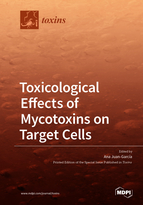Toxicological Effects of Mycotoxins on Target Cells
A special issue of Toxins (ISSN 2072-6651). This special issue belongs to the section "Mycotoxins".
Deadline for manuscript submissions: closed (31 December 2019) | Viewed by 50757
Special Issue Editor
Interests: toxicological effects of food contaminants, specifically mycotoxins; risk assessment of food contaminants with a focus on human’s health; factors that influence intestinal bioavailability and investigation of methods to decrease mycotoxins’ effects; new advanced techniques in elucidating mycotoxins’ toxicological effects implementing the 3R’s principle
Special Issues, Collections and Topics in MDPI journals
Special Issue Information
Dear Colleagues,
The toxicological effects of mycotoxins in humans are evaluated through the extrapolation of results from in vivo and in vitro assays. Studies of mycotoxins’ effects at the cellular level precede those in organs and systems. All these studies are key steps to establish limits of exposure, daily intakes, and a legislation for mycotoxins as well as risk assessment.
The aim of this Special Issue of Toxins is to gather the most recent advances related to the effects of mycotoxins on target cells and their implications for health in any organ or biological system. Therefore, papers dealing with cellular systems as well as animal models for the study of mycotoxins properties are welcome. In this context, also omics data are encouraged. Both research papers and review articles proposing novelties or overviews, respectively, are welcome.
Prof. Dr. Ana Juan-García
Guest Editor
Manuscript Submission Information
Manuscripts should be submitted online at www.mdpi.com by registering and logging in to this website. Once you are registered, click here to go to the submission form. Manuscripts can be submitted until the deadline. All submissions that pass pre-check are peer-reviewed. Accepted papers will be published continuously in the journal (as soon as accepted) and will be listed together on the special issue website. Research articles, review articles as well as short communications are invited. For planned papers, a title and short abstract (about 100 words) can be sent to the Editorial Office for announcement on this website.
Submitted manuscripts should not have been published previously, nor be under consideration for publication elsewhere (except conference proceedings papers). All manuscripts are thoroughly refereed through a double-blind peer-review process. A guide for authors and other relevant information for submission of manuscripts is available on the Instructions for Authors page. Toxins is an international peer-reviewed open access monthly journal published by MDPI.
Please visit the Instructions for Authors page before submitting a manuscript. The Article Processing Charge (APC) for publication in this open access journal is 2700 CHF (Swiss Francs). Submitted papers should be well formatted and use good English. Authors may use MDPI's English editing service prior to publication or during author revisions.
Keywords
- mycotoxins
- cells
- in vitro
- alternative methods
- cytometry, mass cytometry
- metabolomics
- biological system
- genotoxicity
- mutagenicity
- carcinogenicity







